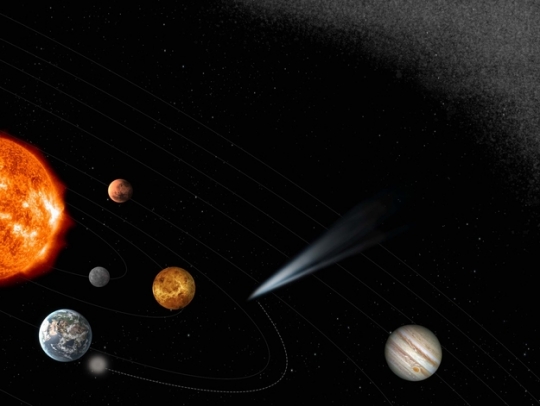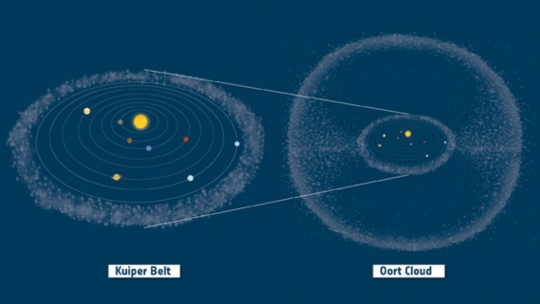Ever since the passage of interstellar interloper ‘Oumuamua, we’ve become aware of the opportunities presented by objects entering our system from interstellar space, at the same time wishing we had the resources at hand to investigate them close-up. Andreas Hein and colleagues at the Initiative for Interstellar Studies have examined the possibilities for reaching ‘Oumuamua through Project Lyra (see Project Lyra: Sending a Spacecraft to 1I/’Oumuamua), a study that also takes in the kind of future infrastructure that could allow us to react to the next such object.
Now comes the interesting news that the European Space Agency is developing a mission called Comet Interceptor, one capable of visiting a long-period comet coming into the inner system from the Oort Cloud, but just as capable of reaching an interstellar visitor. The idea revolves around not a single spacecraft, but a combination of three. The composite vehicle would be capable of orbiting the L2 Lagrange point 1.5 million kilometers from Earth until it finds a suitable target. At that point, it would journey to the object and separate into three modules.

Image: Comet Interceptor has been selected as ESA’s new fast-class mission. It will be the first spacecraft to visit a truly pristine comet or other interstellar object that is only just starting its journey into the inner Solar System. The spacecraft will wait at the Sun-Earth Lagrange point L2, which is 1.5 million kilometres ‘behind’ Earth as viewed from the Sun. It will travel to an as-yet undiscovered comet, making a flyby of the chosen target when it is on the approach to Earth’s orbit. The mission comprises three spacecraft that will perform simultaneous observations from multiple points around the comet. Credit: ESA.
Each module will be equipped with a science payload that complements the instrumentation on the others, offering insights into cometary gas and dust and the plasma environment near the object through a mass spectrometer along with dust, field and plasma instruments. Thus we get ‘multi-point’ measurements offering insights into cometary interactions with the solar wind, the stream of plasma from the Sun that itself is constantly changing in velocity and intensity.
This is a fundamentally different concept from previous missions like Giotto and Rosetta. Giotto flew within 600 kilometers of Comet 1P/Halley in 1986, with another pass by Comet Grigg-Skjellerup in 1992. Rosetta targeted Comet 67P/Churyumov-Gerasimenko in a highly successful mission in 2014. Both comets are short-period objects with periods of less than 200 years, with 67P/Churyumov-Gerasimenko orbiting every 6.5 years and Halley every 76.
In both cases, the comet’s frequent passage into the inner system has meant changes to the surface. What Comet Interceptor is looking for is a first-time visitor, one whose materials should be relatively unprocessed since the earliest days of the system. But ESA is also thinking about interstellar objects like ‘Oumuamua as potential destinations, for the mission has the luxury of being able to choose its target from its stable vantage point at L2. Given the success of the Pan-STARRS effort at finding new comets and the construction of the Large Synoptic Survey Telescope in Chile, slated to reach first light in 2020, we should have no shortage of targets.
ESA director of science Günther Hasinger describes the mission in context:
“Pristine or dynamically new comets are entirely uncharted and make compelling targets for close-range spacecraft exploration to better understand the diversity and evolution of comets. The huge scientific achievements of Giotto and Rosetta – our legacy missions to comets – are unrivalled, but now it is time to build upon their successes and visit a pristine comet, or be ready for the next ‘Oumuamua-like interstellar object.”

Image: Kuiper Belt and Oort Cloud in context. Credit: ESA.
In official terminology, Comet Interceptor is an F-class mission, the ‘F’ standing for ‘fast,’ as in ‘fast implementation’ — the total development time from selection of the mission to readiness to launch is to be eight years. But we might also consider it in terms of ‘fast response,’ just what is needed to reach objects that appear with no prior warning. This category of mission will have a launch mass of less than 1,000 kilograms. Comet Interceptor is now seen going into space along with exoplanet hunter ARIEL in 2028, both missions being delivered to L2.



Awesome plan! But, how frequently are suitable targets expected to inter the inner solar system that would also be able to be reached from Earth’s L2 point?
So we could build a number of these craft to gain scale economies and then leave them parked waiting for targets? What is their propulsion system? What is the possible range of the craft, i.e. does the target have to reach our orbit and at what inclination before it is considered unreachable? How long can the craft stay parked at L2 before it becomes inoperative?
That was my thought, a whole bunch of these parked and ready. The last thing I saw on propulsion is from the ESA executive summary on the Comet Interceptor proposal:
“The most important trades to be considered in more detail in phase 0/A result from the choice between chemical and electrical propulsion (baseline is electrical), and the resulting cost/mass/?v/mission-length balance”
http://www.cometinterceptor.space/uploads/1/2/3/7/123778284/comet_interceptor_executive_summary.pdf
How will this idea conflict with the James Webb Telescope, which will also ‘orbit’ the L2 point?
I don’t see any problem. As NASA puts it re the JWST: “The Webb telescope will be placed slightly off the true balance point, in a gentle orbit around L2.” Lots of room for various missions to do the same. Gaia orbits L2 now, with a number of missions planned to take advantage of L2 in coming years.
Of course the JWST will have to be actually launched into space first.
Ah the Billion dollar question…
You can find that information here:
https://translate.google.com/translate?hl=es&sl=es&tl=en&u=https%3A%2F%2Fdanielmarin.naukas.com%2F2019%2F06%2F20%2Fcomet-interceptor-una-sonda-lista-para-visitar-un-cometa-nuevo-en-cualquier-momento%2F
Here is the official Web site for Comet Interceptor:
http://www.cometinterceptor.space/
University College London press release:
https://www.ucl.ac.uk/news/2019/jun/comet-interceptor-esa-selects-new-mission-ancient-world
Perhaps once this probe is built they can still attempt a mission to Oumuamua with it.
It would have to be fast to keep up with it but a flyby or crash combo would be great, catching at bit would be good as well.
Crash or catch a bit, it can be very original way to welcome supposed interstellar ETI vessel…
That way they will learn something about the general nature of humanity.
Accidents happen all the time !
L2 is unstable so some fuel would be used for station-keeping, which argues against several such craft. Maybe two would be the ideal number, being replaced as they’re used. A stable Lagrange point would seem to be a good place to store anti-asteroid ships, as well.
Ion drives would do well there as they are quite efficient.
True, but the Lagrange points will be very popular and crowded, also. A bunch of ships occasionally firing up could be damaging and unpopular.
The probes can huddle around the Lunar gateway and be taken care of there:
https://en.wikipedia.org/wiki/Lunar_Orbital_Platform-Gateway
https://www.space.com/43018-lunar-orbital-platform-gateway.html
Good joke.
Really? I mean they keep wondering what the Lunar Gateway is actually going to do out there. Well I just gave them one purpose.
One of the original goals for space stations were as maintainers of satellites.
What probes have they maintained?
HUH?? They aren’t crowded at all. The only spacecraft currently orbiting L2 is Gaia. Other 4 missions are planned to orbit L2 during the 2020’s or 2030’s, but Gaia will not be there in 2 or 4 years. And the usual orbits spacecrafts use around L2 are around half a million kilometers in diameter. That’s too big a space to be so easily crowded.
The volume at L2 is very large.
https://academic.oup.com/mnras/article/442/4/3511/1351271
Interesting perhaps these satellite spacecraft could be used as moon GPS as well as they wait for a target.
To me, ‘complementary instruments’ suggests different instrument sets, whereas ‘multi-point measurements’ suggests similar instruments on all the spacecraft – sort of like Cluster. Which is it?
All I have on that is in the ESA document:
“We ensure our highest priority science goals will be achieved by placing three very high TRL instruments (a visible camera based on the Mars TGO/CASSIS flight spare; dust, fields and plasma [DFP] sensors with direct Rosetta heritage; and an infrared camera based on two that are flying in Earth orbit) on the main spacecraft for a safe, relatively distant, flyby. We make use of (mostly) the same DFP sensors on the sub-spacecraft that will pass much closer, to allow direct comparison, simplicity of design, and the use of high TRL systems. These are complemented by a very high TRL mass spectrometer with Rosetta heritage, and two novel low-mass cameras for a small rotating probe, which are the only instruments requiring significant development, but are very simple in design and use high TRL sub-systems with strong flight heritage.”
This Sean Carroll podcast with Natalya Bailey, about 2/3 of the way along, addresses the question of sending a probe to Oumuamua. Too bad Elon didn’t hide one in the trunk of his Tesla Roadster during the BFR test launch :(
https://www.preposterousuniverse.com/podcast/2019/04/15/episode-42-natalya-bailey-on-navigating-earth-orbit-and-beyond/
Maybe we can also send one of these fast probes to intercept the very last flown Apollo Lunar Module ascent stage that didn’t end up either in pieces on the lunar surface or burned up in Earth’s atmosphere:
https://www.skyandtelescope.com/astronomy-news/astronomers-might-have-found-apollo-10-snoopy-module/
Maybe we can launch all of our interstellar visitor probes from our upcoming lunar bases. Low escape velocity and people will be there to maintain them.
How are you so sure that people (and, most importantly, industry) will be there to maintain them? It’s A LOT much easier to build them on Earth. And even considering delta-V alone, it’s totally stupid to send a lot of supplies to build and maintain a lunar base and its crew in order to be able to launch probes from there. It simply doesn’t make any sense at all.
Lots of jobs often do not make “sense”, but they are created anyway to give humans something to do and create new sources of revenue. We are not a very logical species.
That kind of jobs would definitely kill NASA.
In looking over all this, I was wondering for such a mission where you wish to observe/contact an object on a flyby mission, when did stand to reason that the place to station your interceptor would be much greater distances from the sun than currently envisioned?
What I’m thinking about is seeding, perhaps several dozen spacecrafts all distributed say around the points of the zodiac and somewhere in in orbit more closer to Saturn.
There’d be a twofold advantage to doing this type of mission. First off, it would serve to have a chase spacecraft, leaving with a point in space that is much weaker gravitationally due to the sun.
And secondly, the out going body that you intend to examine will have slowed somewhat due to its climb up the gravity well from its closest approach to our sun. I would imagine this would give you a leg up on your Delta V savings, rather than starting from a point related to our Earth’s orbit.
“when did stand to reason that the place to station your interceptor would be much greater “; meant to say:
“would it stand to reason that the place to station your interceptor would be at much greater “
If we find sufficient quantitis of whater on the moon it would becomes attractive also for assembling rokets for the open space. that would make things easy enought to build a kind of spaceport. If they could mine deuterium in abundance it would be also strategic as future nuclear fusion propellant. Technology today make it 100 times cheeper than apollo missions. I always think we need a kind of “space gas station” in a geostationary point somewhere around earth if we whant ships bigger than a phone booth for long term human exploration missions.